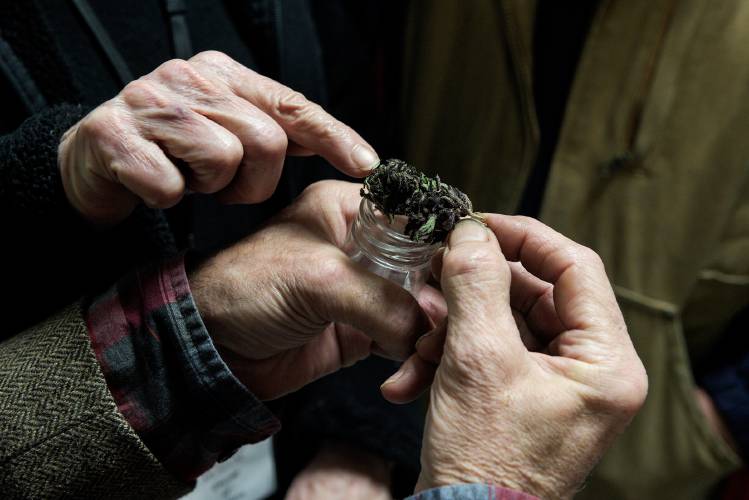Opinion: When it comes to marijuana, there’s no safe way to introduce something unsafe

Customers look over a marijuana bud brought to be tested for its potency at White River Growpro in White River Junction, Vt., in 2018. James M. Patterson / Valley News
| Published: 02-23-2024 6:00 AM |
Joseph A. Ebner, MD, FACOG of Plymouth is a member of the NH Smart Approaches to Marijuana (SAM) Advisory Committee.
As a parent, I am concerned with the rising use of recreational marijuana in society, especially in our youth and young adults. As a physician, I see firsthand the effects of marijuana on health, and it is clear the marijuana on our streets in 2024 is not the same marijuana we or our parents may have smoked in the 1970s.
Daily use of marijuana among Americans more than doubled in the decade from 2010 – 2020 during a period of time when recreational use of marijuana was legalized in many states. In this same decade, while teen cigarette and alcohol use both dropped, marijuana use among teens increased. Public health initiatives seem to have succeeded over the past generation in decreasing tobacco abuse only to be replaced by a new addictive health harm.
So what’s in a name? Marijuana and cannabis are terms that are often used interchangeably to refer to the same plant and the chemical compounds derived from it. THC (Delta-9-tetrahydrocannabinol) is the main intoxicating component of marijuana, which gives the user a euphoric high. But today’s marijuana is radically different from the pot of the past.
“Woodstock weed” from the 1970s contained roughly 3% THC (that psychoactive component above). Over the past 50 years the potency of the marijuana plant through selective breeding has increased to an average potency of 23% THC found today. This potency of THC applies only to the marijuana flower (or bud) that is simply dried and smoked. You see, THC can be chemically concentrated into products containing 95 – 99% THC. THC concentrates come as shatter, budder, waxes, dabs, gummies and edibles. Concentrates can be vaped, smoked, or eaten.
Comparing today’s marijuana to that of the past is like comparing Ford’s Model T car to a Tesla. Both are automobiles, but other than that, they share very little in common.
The health concerns with marijuana come from the highly potent forms found in today’s market, not available decades ago. Marijuana use is a serious public health concern identified in many state Departments of Health because of the significant number of negative health effects associated with it, such as impaired driving, child overdose, marijuana-associated nausea and vomiting, and addiction withdrawal. High potency and high frequency marijuana use are also associated with severe impacts on mental health, prompting a warning from the U.S. Surgeon General in 2019 about the adverse effects on the brain.
Marijuana in 2024 is highly addictive and long-term use of marijuana is associated with the development of Cannabis Use Disorder (CUD). CUD is a problematic pattern of marijuana use that leads to worsened academic and work performance resulting in significant functional impairment or distress with relationships at the workplace or in school. The defining feature of CUD is the loss of control over marijuana use and persisting in use despite knowledge of adverse consequences. Marijuana use can produce chronic mood changes such as depression and studies also support an association between marijuana use and exacerbation of mania in those with bipolar disorder.
Article continues after...
Yesterday's Most Read Articles
Approximately half of chronic users of high potency marijuana will experience withdrawal symptoms upon cessation: sleep difficulty, irritability or anger, anxiety, headache, and depressed mood. These uncomfortable symptoms can be significant enough for the resumption of marijuana use in a large proportion of individuals, leading to years of addiction.
Perhaps most distressing to me as a physician is the substantial evidence that chronic marijuana use is associated with an increased risk of psychosis and the development of schizophrenia. Even more distressing is the fact that adolescents and young adults who frequently use high-potency marijuana are most at risk of this long-term, chronic mental illness.
Marijuana use is rapidly increasing concurrent with legalization changes throughout the United States. Youth use in legal states is higher than non-legal states, even though no state has legalized recreational marijuana for children under 18. Parental marijuana use increases the likelihood of marijuana and tobacco use and opiate misuse among household children.
New Hampshire HB 1633 is another attempt to “safely” introduce recreational marijuana into our state (at a time when we are still struggling with an opioid epidemic). The reality is there is no safe way to introduce something that is unsafe. I hope as a parent you will educate yourself on today’s marijuana and share your concern with your state representative.
To learn more about the negative impacts legalized marijuana is having on other states and on our youth, please take a few moments to review the 2023-2024 SAM Impact Report at liprc.org/info/sam-impact-report-2023-2024-lessons-learned-from-state-marijuana-legalization/







 Opinion: There’s no place like firearms-free zones
Opinion: There’s no place like firearms-free zones Opinion: Outlines of a new dystopia
Opinion: Outlines of a new dystopia Opinion: Speechless in America no more
Opinion: Speechless in America no more Opinion: Friends don’t let friends drive drunk
Opinion: Friends don’t let friends drive drunk
